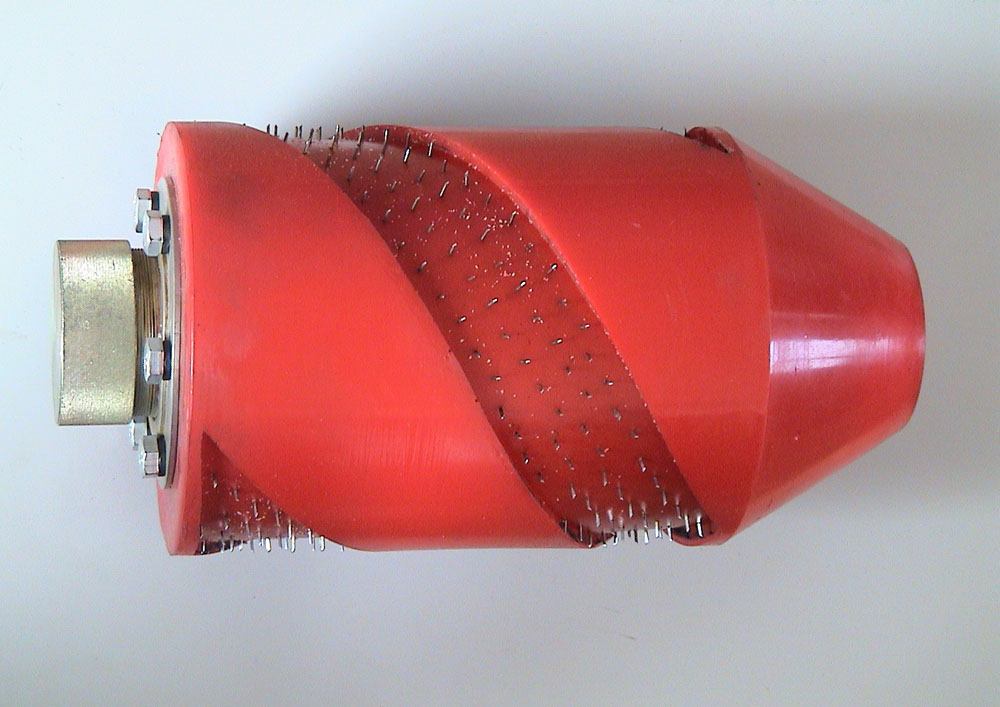The maintenance tool, pipeline pigs are introduced into the line via a pig trap, which includes a launcher and receiver. Without interrupting flow, the pig is then forced through it by product flow, or it can be towed by another device or cable. Usually cylindrical or spherical, pigs sweep the line by scraping the sides of the pipeline and pushing debris ahead. As the travel along the pipeline, there are a number functions the pig can perform, from clearing the line to inspecting the interior.
| Illustrastion of pigging |
 |
| Pig Foam |
There are two main hypotheses for why the process is called "pipeline pigging," although neither have been proved. One theory is that "pig" stands for Pipeline Intervention Gadget. The other states that a leather-bound pig was being sent through the pipeline, and while it passed, the leather squeaked against the sides of the pipe, sounding like a squealing pig.
Engineers must consider a number of criteria when selecting the proper pig for a pipeline. First, it's important to define what task the pig will be performing. Also, size and operating conditions are important to regard. Finally, pipeline layout is integral to consider when choosing a pig.
Because every pipeline is different, there is not a set schedule for pigging a line, although the quantity of debris collected in a pipeline and the amount of wear and tear on it can increase the frequency of pigging. Today, pipeline pigging is used during all phases of the life of a pipeline.
Types Of Pipeline Pigs
Although first used simply to clear the line, the purpose of pipeline pigging has evolved with the development of technologies. Utility pigs are inserted into the pipeline to remove unwanted materials, such as wax, from the line. Inline inspection pigs can also be used to examine the pipeline from the inside, and specialty pigs are used to plug the line or isolate certain areas of the line. Lastly, gel pigs are a liquid chemical pigging system.
Inspection pigs, also referred to as in-line
inspection pigs or smart pigs, gather information about the pipeline from
within. . The type of information gathered by smart pigs includes the pipeline
diameter, curvature, bends, temperature and pressure, as well as corrosion or
metal loss. Inspection pigs utilize two methods to gather information about the
interior condition of the pipeline: magnetic flux leakage (MFL) and ultrasonics
(UT). MFL inspects the pipeline by sending magnetic flux into the walls of the
pipe, detecting leakage, corrosion, or flaws in the pipeline. Ultrasonic
inspection directly measures the thickness of the pipe wall by using ultrasonic
sounds to measure the amount of time it takes an echo to return to the sensor
Specialty pigs, such as plugs, are used to isolate a
section of the pipeline for maintenance work to be performed. The pig plug
keeps the pipeline pressure in the line by stopping up the pipeline on either
side of where the remedial work is being done.
A combination of gelled liquids, gel pigs can
be used in conjunction with conventional pigs or by themselves. Pumped through
the pipeline, there are a number of uses for gel pigs, including product
separation, debris removal, hydrotesting, dewatering and condensate removal, as
well as removing a stuck pig.
Because there now exist multi-diameter pipelines, dual and
multi-diameter pigs have been developed, as well.
No comments:
Post a Comment